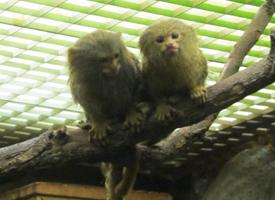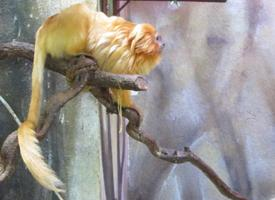
Váhy a míry
| Hmotnost | od 120 do 140 g |
|---|---|
| Délka ocasu | od 15 do 20 cm |
Biologická data
| Délka života | 11 r |
|---|---|
| Délka březosti | od 120 do 140 d |
| Počet mláďat | 2 - 3 |
Popis zvířete
The Western Pygmy Marmoset (Callithrix pygmaea), also known as the Pygmy Marmoset, is a diminutive primate that captivates the imagination with its minuscule stature and remarkable behaviors. Native to the rainforests of western South America, including regions in Brazil, Colombia, Ecuador, and Peru, this tiny creature has adapted remarkably well to its lush, arboreal habitat.One of the most striking features of the Western Pygmy Marmoset is its size. As one of the smallest primates in the world, it weighs a mere 100 to 120 grams (about 3.5 to 4.2 ounces) and measures around 12 to 15 centimeters (4.7 to 5.9 inches) in length, not including its tail, which can add an additional 15 to 20 centimeters (5.9 to 7.9 inches). This makes it small enough to fit in a human's hand.
Its fur is predominantly a mixture of brown, gray, and gold, allowing it to blend seamlessly into the forest canopy. The marmoset's face is adorned with white markings around the eyes and mouth, giving it a distinctive appearance. Its large, expressive eyes are a necessity for its diurnal lifestyle, enhancing its vision in the dense forests where sunlight is often scarce.
One of the most fascinating aspects of the Western Pygmy Marmoset's behavior is its diet, which is highly specialized. It primarily feeds on tree gum, utilizing its sharp, specialized teeth to gnaw holes into bark to access the sap. This adaptation is unique among primates and signifies the marmoset's evolutionary niche. In addition to tree gum, it also consumes fruits, insects, and small reptiles, showcasing its omnivorous diet.
Socially, the Western Pygmy Marmoset lives in small, close-knit groups typically consisting of two to nine individuals. These groups often include a breeding pair and their offspring, highlighting a complex social structure that includes cooperative care of the young, territory defense, and intricate communication methods. Vocalizations, facial expressions, and body postures are all part of their communication repertoire, essential for maintaining social bonds and navigating their environment.
Reproduction in the Western Pygmy Marmoset involves a fascinating parental care system where not only the mother but also the father and other group members partake in caring for the young. Females typically give birth to twins, which is quite rare among primates. The communal care of offspring ensures a higher survival rate, a crucial adaptation for their continuation as a species.
The Western Pygmy Marmoset's habitat, the dense rainforests of South America, is under constant threat from deforestation and habitat destruction. While they are currently listed as a species of Least Concern by the International Union for Conservation of Nature (IUCN), their population is at risk due to ongoing environmental pressures. Conservation efforts are essential to ensure the survival of this unique primate and the preservation of its rainforest home.
In conclusion, the Western Pygmy Marmoset is a remarkable example of adaptation and survival in the animal kingdom. Its minuscule size, specialized diet, and complex social structures make it a fascinating subject of study for scientists and a beloved animal for wildlife enthusiasts. As we continue to learn more about these tiny primates, it becomes increasingly important to protect them and their habitat for future generations to marvel at and enjoy.
Podobná zvířata
Nové fotografie zvířat
Top 10 zvířat
- Chinese water dragon (Physignathus cocincinus)
- Galápagos tortoise (Geochelone nigra complex)
- Dolphin gull (Leucophaeus scoresbii)
- Japanese macaque (Macaca fuscata)
- Colombian red howler (Alouatta seniculus)
- Sea urchins (Echinoidea)
- Moustached guenon (Cercopithecus cephus)
- Diana monkey (Cercopithecus diana)
- Colossal squid (Mesonychoteuthis hamiltoni)
- Common house mosquito (Culex pipiens)
